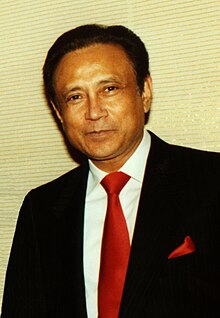Mani Lal Bhaumik
| Mani Bhaumik মণি ভৌমিক | |
|---|---|

Mani Bhaumik
|
|
| Born | 1931 Midnapore, West Bengal, India |
| Residence | Beverly Hills, Los Angeles, CA, US |
| Citizenship | United States |
| Fields | Physicist |
| Institutions | University of California, Los Angeles, California State University, Long Beach |
| Alma mater |
University of Calcutta IIT Kharagpur |
| Academic advisors | Satyendranath Bose |
Mani Lal Bhaumik is an Indian-born American physicist and a bestselling author.
Bhaumik was born on March 30, 1931 in a small village in Siuri, Medinipore, West Bengal, India and attended the Krishnagang krishi silpa vidyalaya school. As a teenager, Bhaumik spent some time with Mahatma Gandhi in his Mahisadal camp. He received a Bachelor of Science degree from Scottish Church College and an M. Sc. from the University of Calcutta. He won the attention of Satyendra Nath Bose (creator of the Bose–Einstein statistics) who encouraged his prodigious curiosity. Bhaumik became the first student to receive a Ph.D. degree from the Indian Institute of Technology Kharagpur when he received his Ph.D. in quantum physics in 1958. His thesis was on Resonant Electronic Energy Transfers, a subject he would have cause to use in his work with lasers.
Receiving a Sloan Foundation Fellowship in 1959, Bhaumik went to the University of California Los Angeles (UCLA) for post doctoral studies. In 1961, he joined the Quantum Electronics Division at Xerox Electro-Optical Systems in Pasadena and began his career as a laser scientist. Concurrently, he taught Quantum physics and Astronomy at the California State University at Long Beach. In 1968, he was enlisted by the Northrop Corporate Research Laboratory, where he rose to become the director of the Laser Technology Laboratory and led a team that made contributions in research on excimer laser technology. One of the papers on this research was presented at the Denver, Colorado meeting of the Optical Society of America in May 1973. At this meeting, Dr. Bhaumik presented substantial evidence to demonstrate for the first time that an excimer laser could be efficient and powerful enough for practical utilization. The application of excimer lasers in Lasik eye surgery has resulted in vision correction in many cases. His contributions to the development of new and high power lasers merited his election by his peers to be a fellow of both the American Physical Society and the Institute of Electrical and Electronics Engineers.
...
Wikipedia
